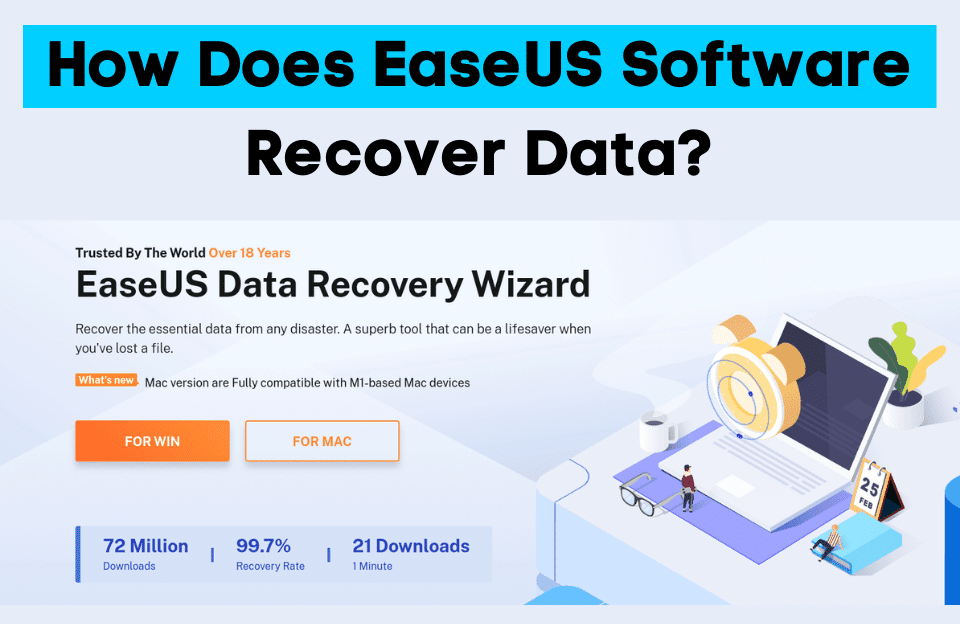I understand so that I might believe
Hey, if you’re looking for a tutorial, feel free to check out our article on file transfer with EaseUS software!
A fair warning here:
This is no usual review of the program. I dive on few of the concepts that relate with data recovery to try to explain how does their software work based on the technical descriptions of certain aspects of their programs from their patents. Finally, I hope my explanations are understandable, and that the article is nice read.
Introduction
Personally, as an adept internet user, EaseUS is a name that does ring a bell every time I hear it.
It has become well-established due to its data recovery software, including other great account of programs you can readily encounter on a search. In fact, one of these, their EaseUS Data Recovery Wizard, dates back to 2005: almost 17 years! [1–2].
To evidence the quality of their software, our Chinese fellows have also patented how their programs operate under the hood. They may even account for hundreds of patents! [3]
If you’re interested, you can look over a list of some of their patents in Google Patents [4].
Yet, for the average person, it may be trivial to even bother reading through these. What’s the purpose? You may have heard of the erstwhile phrase of “see to believe”. In our case, is not seeing, but understanding what’s happening to recover your data.
As you may know, you have to trust the software first before even downloading it, or rather spending your money into the company in the first place, in particular with programs that deal with important data.
This premise may pop up several questions:
Can EaseUS ensure safeguards of getting data back?
- In most of the cases it covers, thereby their “99.99% recovery rate” [3], which is exaggerated, but let’s take that out of account.
What does it cover then?
- Logical issues — and that’s overly summarized.
What does that even mean?
- As you may have seen, before proceeding to that point, it’s worth noting that it’s better to fully comprehend how does EaseUS help you recover your data, and what does that mean for a disk that can be recovered without any professional knowledge or equipment.
A Bit of a Dive into Data Recovery
One rule of gold is to back up data on a regular basis. Otherwise, how do you know a disk can be recovered? It’s safe to start by understanding the different types of issues a disk can have, and then jumping to a straight conclusion.
These include logical/software problems and physical/hardware issues. It may be readily evident when does one apply and when does the other, but sometimes it doesn’t.
Logical/software issues
In summary, they include problems that some programs, the operative system, or the computer may have while trying to access a disk or part of the disk that has been corrupted or damaged, including a partition or a bad disk sector, as explained by one of their patents [5]. If you’re interested, Linus Tech Tips showcases such scenario:
Then, what is a partition?
In general, it’s one of the regions of a disk – split with the main purpose of being managed separately, and so is used for a particular intention regarding the data that is stored within [6, p. 176-7] & [7].
For example, on a modern system, Windows requires multiple partitions to be used [8]:
- A “boot” partition, which allows the computer to power on Windows.
- The system partition, which contains the files that Windows needs to operate.
- A reserved partition, which allows Windows to manage the whole disk.
Yet, Windows also creates a “recovery” partition, which – opposite to common sense, by no means can recover data, but allows troubleshooting Windows in a specialized environment [9], which is worth noting in case any other partition is inaccessible, corrupt or accidentally deleted if data is compromised. In fact, EaseUS has a Partition Recovery software that for those who are interested can check out.
What about a disk sector?
In a disk, being a “slow” mechanical system, a sector embodies a unit of data that is transferred back and forth from the drive in a single operation.
In fact, it is the smallest amount of data that can be stored, and is used to reconstruct chunks of information, where it lies its importance.
Historically, its size diverged from tens of bytes to the current standard of four kilobytes, a small yet tremendous change over time [see 10, p. 1691-2 & 11].
Ultimately, as explained by Mental Outlaw in the following video, these problems, can be caused by a sudden shutdown of the disk while it’s still running, which can corrupt the sectors being accessed – and, as explained, can wholly corrupt any files residing on those; or can impede access to the data inside a partition as a whole.
Yet, a sudden shutdown isn’t limited to corrupting chunks of data, but it can also corrupt the firmware, i.e. the embedded software that allows the disk to be used on a system, which requires sophisticated equipment/knowledge to be fixed, and is costly to afford.
Physical/hardware issues

Evidently, any physical damage applies into this category, and thence varies on severity. Yet, it also includes damage caused by power imbalances, such as those provoked from a power outage, as showcased by Linus at the start of the video.
Compared to logical issues, these can also be costly to afford fixing, depending on the damage.
Now dived into the most fundamental concepts of the disks and issues themselves, it’s safe to start explaining how does EaseUS Data Recovery software work.
How can EaseUS recover data then?

Taking from the explanation on logical damage, based on their patent, EaseUS software is capable of properly loading a logical damaged disk that would otherwise freeze, error or even crash while trying to access the files within.
Under the hood, after Windows, for instance, grasps the structure of the whole disk and of its partitions, it tries to read data out of each, yet if it encounters one as invalid or unreadable, the whole process can be stuck at trying, error or crash, which may also have an effect on the system [5].
You may ask: Why would Windows keep trying when it encounters an abnormality on the partition?
As Linus nicely puts, consumer systems, such as Windows, expect the drives to work, and will keep trying, when they otherwise assume they can be the problem. Whereas recovery tools expect the drive not to work properly, and anticipate that the drives have issues; alike how a diagnostic tool would.
Ultimately, it’s better trying than not. Better take care of our precious drives!
He who does not believe will not under stand. For he who does not believe will not experience, and he who has not had experience will not know.



Amazing Site, I hadn’t noticed onhaxpk.net before my searches!
Carry on the vast work!
welcome.